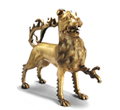Beard, Mary & John Henderson. Classical Art from Greece to Rome. Oxford University Press, 2001.
This volume in the Oxford History of Art series is a lively analysis of several cultural concepts that figure in the transmission of Greek and later Roman art to later ages. It starts with the discovery of Pompeii, goes on to discuss Roman monuments erected by flamboyant Roman emperors, parses ancient images of sexuality, and ends with an analysis of the desire for portraiture. Beard and Henderson help one understand how the Romans received Greek art and how later ages received both. The illustrations are as lively as the text.
D’Ambra, Eve. Roman Art. London: Cambridge University Press, 1998.
D’Ambra discusses particular aspects of Roman culture that help explain Roman art. For example, she explains the Roman social order, the Roman idea of a city as the center of civilization, and the importance to the Romans of visual commemoration. Another example is the relationship between a sense of duty and family and the architecture and decoration of houses and gardens. Many color illustrations whet the appetite for more.
Goldsworthy, Adrian. The Complete Roman Army. London: Thames and Hudson, 2003.
Beginning with a brief, useful survey of Roman history, this compendium is an excellent introduction to development and structure of the Roman army from volunteers to professionals. It also provides interesting material of the life of a Roman soldier (“Daily Routine, Equipment,” etc.), descriptions of the army at war (“Battle, Siege,” etc.), and the Roman army in late antiquity. The many illustrations are also helpful.
Strong, Donald. Roman Art. 2nd ed. New Haven: Yale University Press, 1988, 1995.
This handbook is a useful presentation of the kinds of Roman art and decoration. It is arranged chronologically. The section on the transition in the arts from the Republic to the Empire under Augustus is useful, though brief. One can also follow a particular kind of art, such as portraiture, through the various historical periods. The many illustrations are black and white but of high quality.
Strong, Donald & David Brown. Roman Crafts. New York: New York University Press, 1976.
This is a collection of expert essays on different crafts invented and/or perfected by Roman craftsmen. The chapter on glass-making is an excellent introduction to this quintessentially Roman product. There are several full-color plates as well as many black and white illustrations.
Syme, Ronald. The Roman Revolution. London: Oxford University Press, 1939, 2002.
This is the definitive history of the momentous changes that occurred in Rome between 60 B.C. and 14 A.D. when Augustus Caesar came to power. It explains in great detail the political maneuverings of powerful Roman families during the last years of the Roman republic after the assassination of Julius Caesar and the process by which the Civil War led to oligarchy and finally the principate of Augustus, who seems an unlikely first emperor until one looks at his political savvy. Syme is heavy reading because of the many names and untranslated Latin phrases, but he is brilliant on the manipulating of power.
Zanker, Paul. The Power of Images in the Age of Augustus. Ann Arbor: University of Michigan Press, 1988.
This is the definitive book on art under Augustus. Zanker’s thesis, that Augustus Caesar used art to consolidate the centrality of Rome and his own power over the new empire, is the thesis of my own audio tour. Zanker carefully examines the imperial mythology that Augustus developed and that is reflected in Roman sculpture, architecture, portraiture, even in the decorative arts. The discussion of the images of Augustus himself, from the colossal heads of statues erected throughout the empire to the small gemstones carved with his image, is especially interesting.

